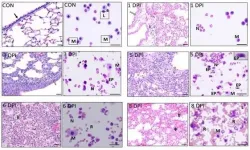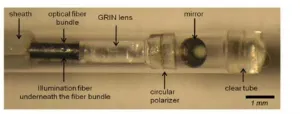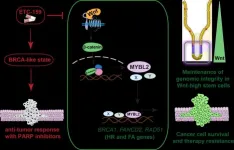Practical nanozymes discovered to fight antimicrobial resistance
2021-03-16
(Press-News.org) Nanozymes, a group of inorganic catalysis-efficient particles, have been proposed as promising antimicrobials against bacteria. They are efficient in killing bacteria, thanks to their production of reactive oxygen species (ROS).
Despite this advantage, nanozymes are generally toxic to both bacteria and mammalian cells, that is, they are also toxic to our own cells. This is mainly because of the intrinsic inability of ROS to distinguish bacteria from mammalian cells.
In a study published in Nature Communications, the research team led by XIONG Yujie and YANG Lihua from University of Science and Technology (USTC) of the Chinese Academy of Sciences (CAS) proposed a novel method to construct efficient-while-little-toxic nanozymes.
The researchers showed that nanozymes that generate surface-bound ROS selectively kill bacteria, while leaving the mammalian cells safe.
The selectivity is attributed to, on the one hand, the surface-bound nature of ROS generated by the nanozymes prepared by the team, and on the other hand, an unexpected antidote role of endocytosis, a cellular process that is common for mammalian cells while absent in bacteria.
Moreover, the researchers observed a few different nanozymes that generate surface-bound ROS but vary in chemical components and in physical structures, ending up finding that the anti-bacteria behaviors are similar. This fact brings to the conclusion that the advantage of selectively killing bacteria over mammalian cells is the general property of the nanozymes that produce surface-bound ROS.
Antimicrobial resistance (AMR) poses a threat to global health, which is the reason why our use of drugs against germs are gradually less effective.
INFORMATION:
ELSE PRESS RELEASES FROM THIS DATE:
2021-03-16
Females who are fit and healthy tend to burn more fat when they exercise than men, according to new research from a team of sports nutritionists.
The research, comprising two new studies from academics led by the University of Bath's Centre for Nutrition, Exercise & Metabolism, analysed the factors that most influenced individuals' capacity to burn body fat when undertaking endurance sports.
How the body burns fat is important to all of us for good metabolic health, insulin sensitivity and in reducing the risk of developing Type II diabetes. But, for endurance sport ...
2021-03-16
Research led by the Cavendish Laboratory at the University of Cambridge has identified a material that could help tackle speed and energy, the two biggest challenges for computers of the future.
Research in the field of light-based computing - using light instead of electricity for computation to go beyond the limits of today's computers - is moving fast, but barriers remain in developing optical switching, the process by which light would be easily turned 'on' and 'off', reflecting or transmitting light on-demand.
The study, published in Nature Communications, shows that a material known as Ta2NiSe5 could switch between a window and a mirror in a quadrillionth of a second when struck by a short laser pulse, paving the way for the development ...
2021-03-16
The bacterial equivalent of a traffic jam causes multilayered biofilms to form in the presence of antibiotics, shows a study published today in eLife.
The study reveals how the collective behaviour of bacterial colonies may contribute to the emergence of antibiotic resistance. These insights could pave the way to new approaches for treating bacterial infections that help thwart the emergence of resistance.
Bacteria can acquire resistance to antibiotics through genetic mutations. But they can also defend themselves via collective behaviours such as joining together ...
2021-03-16
The inclusion of a special new perovskite layer has enabled scientists to create a "spin-polarized LED" without needing a magnetic field or extremely low temperatures, potentially clearing the path to a raft of novel technologies.
Details of the research conducted at the National Renewable Energy Laboratory (NREL) and the University of Utah appear in the journal Science.
Researchers at NREL and around the world have been investigating the use of perovskite semiconductors for solar cells that have proven to be highly efficient at converting sunlight to electricity. Since a solar cell is one of the most demanding applications of any semiconductor, scientists are discovering other uses exist as well.
"We are exploring the fundamental properties of metal-halide ...
2021-03-16
Philadelphia, March 16, 2021 - A significant proportion of hospitalized patients with influenza develop complications of acute respiratory distress syndrome, driven by virus-induced cytopathic effects as well as exaggerated host immune response. Reporting in The American Journal of Pathology, published by Elsevier, investigators have found that treatment with an immune receptor blocker in combination with an antiviral agent markedly improves survival of mice infected with lethal influenza and reduces lung pathology in swine-influenza-infected piglets. Their research also provides insights into the optimal timing of treatment to prevent acute lung injury.
Previously, the investigators found ...
2021-03-16
WASHINGTON -- Researchers have developed a new intravascular imaging technique that could one day be used to detect coronary plaques that are likely to lead to a heart attack. Heart attacks are often triggered when an unstable plaque ruptures and then blocks a major artery that carries blood and oxygen to the heart.
"If unstable coronary plaques could be detected before they rupture, pharmacological or other treatments could be initiated early to prevent heart attacks and save lives," said research team leader Seemantini Nadkarni from the Wellman Center for Photomedicine at Massachusetts General Hospital. "Our new imaging technique represents a major step toward achieving this."
In The Optical Society (OSA) journal Biomedical ...
2021-03-16
MADISON, Wis. -- Millions of people are administered general anesthesia each year in the United States alone, but it's not always easy to tell whether they are actually unconscious.
A small proportion of those patients regain some awareness during medical procedures, but a new study of the brain activity that represents consciousness could prevent that potential trauma. It may also help both people in comas and scientists struggling to define which parts of the brain can claim to be key to the conscious mind.
"What has been shown for 100 years in an unconscious state like sleep are these slow ...
2021-03-16
Low doses of propylparaben - a chemical preservative found in food, drugs and cosmetics - can alter pregnancy-related changes in the breast in ways that may lessen the protection against breast cancer that pregnancy hormones normally convey, according to University of Massachusetts Amherst research.
The findings, published March 16 in the journal Endocrinology, suggest that propylparaben is an endocrine-disrupting chemical that interferes with the actions of hormones, says environmental health scientist Laura Vandenberg, the study's senior author. Endocrine ...
2021-03-16
Universal fault-tolerant quantum computing relies on the implementation of quantum error correction. An essential milestone is the achievement of error-corrected logical qubits that genuinely benefit from error correction, outperforming simple physical qubits. Although tremendous efforts have been devoted to demonstrate quantum error correcting codes with different quantum hardware, previous realizations are limited to be against certain types of errors or to prepare special logical states. It remains one of the greatest and also notoriously difficult challenges to realize a universal quantum error correcting code for more than a decade.
In a new research article published in the ...
2021-03-16
SINGAPORE, 16 March 2021 - ETC-159, a made-in-Singapore anti-cancer drug that is currently in early phase clinical trials for use in a subset of colorectal and gynaecological cancers, could also prevent some tumours from resisting therapies by blocking a key DNA repair mechanism, researchers from Duke-NUS Medical School and the Agency for Science, Technology and Research (A*STAR) in Singapore reported in the journal EMBO Molecular Medicine.
Among the many therapies used to treat cancers, inhibitors of the enzyme poly (ADP ribose) polymerase (PARP) prevent cancer cells from repairing naturally occurring DNA damage, including unwanted/harmful breaks in the DNA. When too many breaks accumulate, the cell dies.
"Some cancers have an overactive Wnt signalling pathway that may make them ...
LAST 30 PRESS RELEASES:
[Press-News.org] Practical nanozymes discovered to fight antimicrobial resistance





